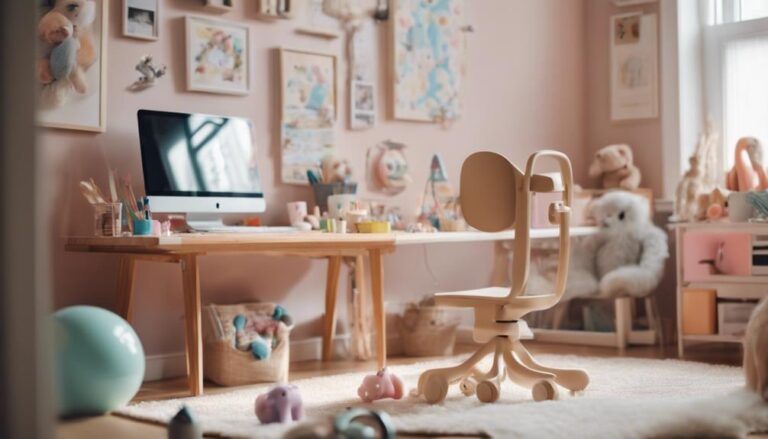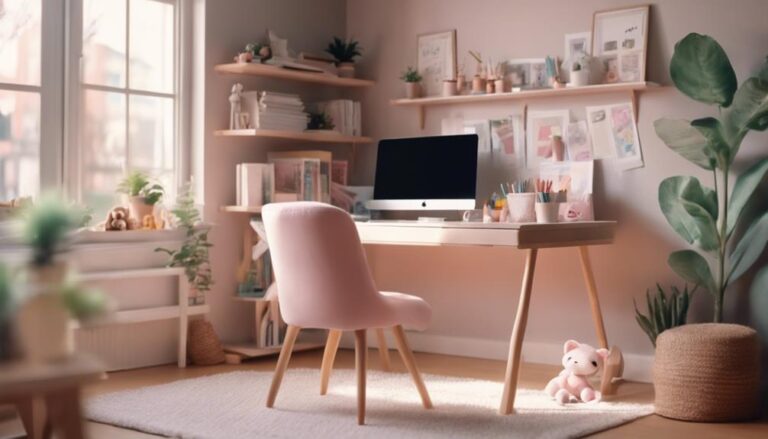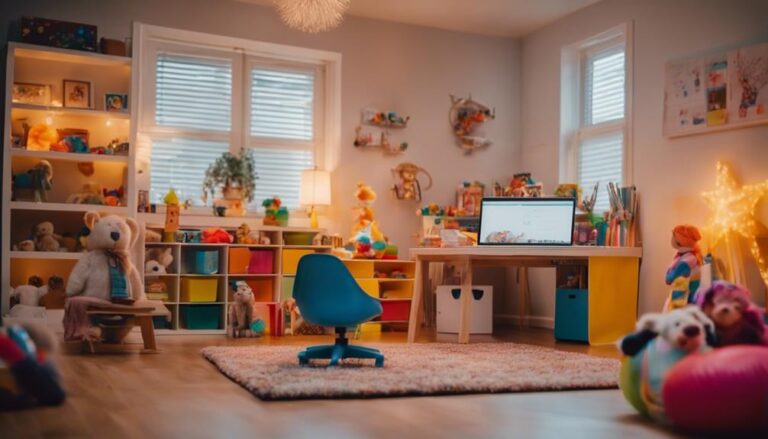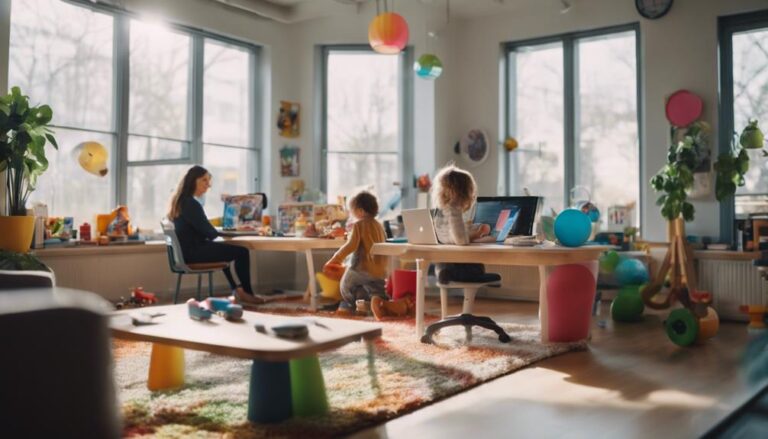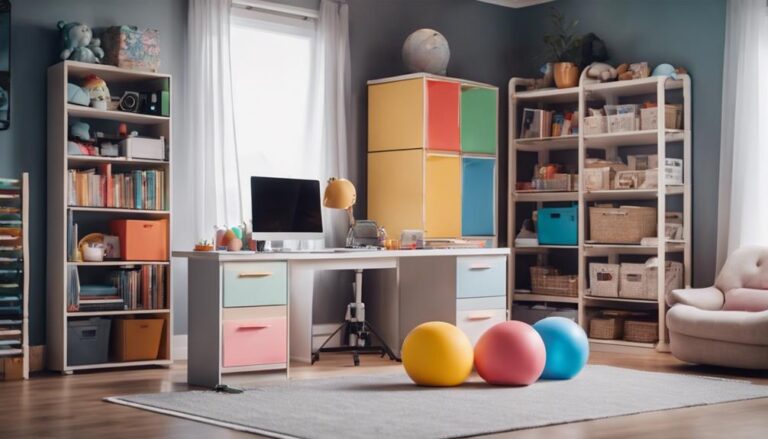When setting up a kid-friendly workspace, I prioritize several key factors. First, I choose a location that suits their age and learning style. Child-sized, ergonomic furniture guarantees comfortable posture. Proper lighting, like natural light and adjustable lamps, minimizes eye strain. I also minimize distractions using noise-cancelling headphones and set ground rules for family interruption. Organizational tools, such as labeled bins and wall organizers, keep everything in place. Safety is paramount, so I secure heavy furniture and use childproof accessories. Personalizing the space with photos and artwork makes it welcoming. Establishing rules and consistent study times helps maintain focus. Explore further to enhance your child's workspace setup.
Key Takeaways
- Choose a comfortable, ergonomic chair and desk to promote good posture.
- Utilize natural light and adjustable desk lamps to reduce eye strain.
- Use labeled storage bins and wall organizers for efficient organization.
- Create a distraction-free zone with noise-cancelling headphones and 'Do Not Disturb' signs.
- Personalize the space with favorite colors and decorations to make it inviting and motivating.
Choose the Right Location
Selecting the appropriate location for your child's workspace is essential for their focus and productivity. When choosing a location, I always consider my child's age and learning style.
For younger kids who need supervision, a central location like the kitchen or living room works best. This way, I can easily keep an eye on them.
For older children, an out-of-the-way spot minimizes distractions, helping them concentrate better. However, I've found that setting up a workspace in the bedroom can impact how effectively my child can study and stay productive, so it's worth taking the time to find the perfect spot.
Invest in Child-Sized Furniture
When setting up a kid-friendly workspace, investing in child-sized furniture is vital.
I believe that furniture designed with ergonomic considerations guarantees comfort and promotes proper posture, which is essential for their development.
Let's explore how age-appropriate comfort can empower children and make their study area both engaging and functional.
Ergonomic Design Benefits
Investing in child-sized furniture not only promotes proper posture but also enhances comfort for young learners. With an ergonomic design, adjustable chairs and desks are tailored specifically to children's needs. This thoughtful design prevents strain on young bodies, fostering a healthy study environment.
By providing child-sized furniture, I'm encouraging independence and boosting focus during study sessions. These elements are essential for nurturing good study habits and a positive learning experience. Ergonomic design guarantees that every piece of furniture supports the child's physical well-being, making learning both enjoyable and efficient.
Let's embrace these innovative solutions to create spaces that truly cater to our children's developmental needs.
Age-Appropriate Comfort
By prioritizing age-appropriate comfort, I can guarantee that my child's workspace isn't only ergonomic but also engaging and tailored to their developmental stage.
Investing in child-sized furniture is essential for promoting ergonomic comfort and proper posture. A small, sturdy desk and chair designed for children's height and size assure that they sit correctly and comfortably. Adjustable furniture options are fantastic because they grow with my child, offering lasting value.
I also choose colorful and fun designs to make the workspace inviting and stimulating. This approach encourages my child's independence and gives them a sense of ownership over their study space.
Ultimately, child-sized furniture transforms their learning environment into a supportive and innovative haven.
Ensure Proper Lighting
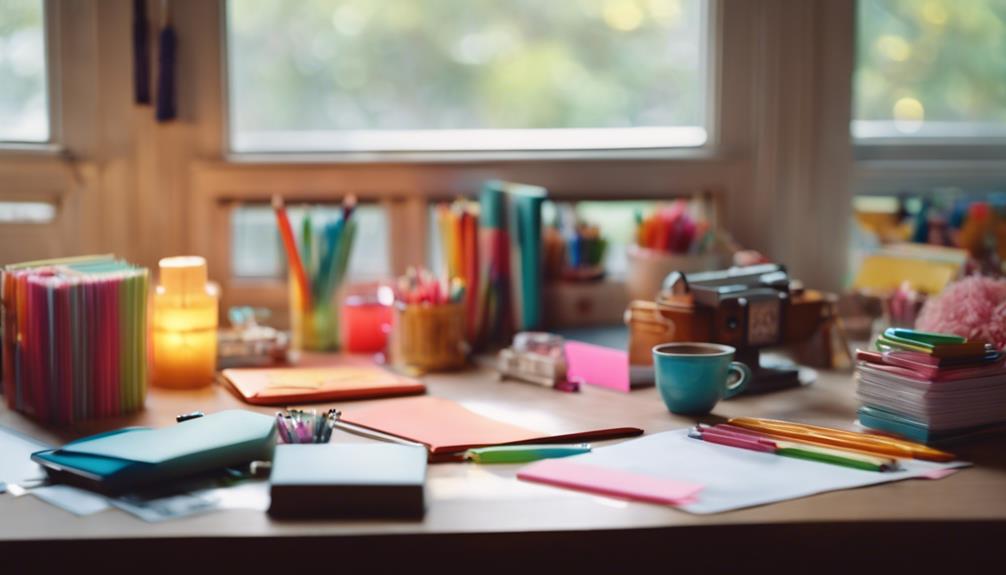
When setting up a kid-friendly workspace, I always prioritize proper lighting to support their focus and comfort. Positioning the desk near natural light can reduce eye strain, while using adjustable desk lamps guarantees the right amount of light for different tasks.
Additionally, glare-free screens help maintain a clear and comfortable visual environment.
Natural Light Sources
Positioning your child's workspace near a window guarantees they benefit from ample natural light, reducing eye strain and boosting productivity. Natural light sources are essential for creating a kid-friendly workspace that fosters a positive learning environment.
Exposure to natural light not only enhances mood and well-being but also guarantees proper lighting for reading, writing, and other tasks. To maximize these benefits, I use curtains or blinds to control the amount of sunlight entering the workspace, allowing for a comfortable and adaptable setting throughout the day.
Adjustable Desk Lamps
Adjustable desk lamps provide the ideal solution for guaranteeing your child has the right amount of light for any task, making study sessions more effective and comfortable. With customizable lighting options, these desk lamps can reduce eye strain and improve focus. Features like flexible necks allow you to direct light exactly where it's needed. LED desk lamps are particularly energy-efficient and offer varying brightness levels. Some even come with color temperature settings, creating a comfortable and productive environment.
Here's a quick comparison:
| Feature | Benefit | Example |
|---|---|---|
| Adjustable Brightness | Reduces eye strain | LED desk lamps |
| Flexible Necks | Precise lighting | Lamps with flexible arms |
| Color Temperature | Custom environment | Multi-setting desk lamps |
Using these features guarantees your child's workspace is perfectly lit.
Glare-Free Screens
Avoiding screen glare is essential for reducing eye strain and ensuring a comfortable viewing experience for your child. Proper screen positioning is key. Place screens where they won't catch reflections from windows or overhead lights. This simple step greatly aids in glare reduction.
Additionally, adjustable curtains or blinds help control natural light, keeping screen reflections at bay.
Investing in anti-glare screen protectors can also enhance visibility. For artificial lighting, choose desk lamps with adjustable brightness. This way, you can provide adequate lighting without adding glare on screens.
Minimize Distractions
To help your child stay focused during study time, you can use noise-cancelling headphones or earplugs to block out auditory distractions.
Keep the work space free from visual interruptions by setting up DIY cubicles or portable study pods. Visual cues like 'Do Not Disturb' signs or colored flags can signal when it's time for focus and privacy, enhancing their ability to concentrate.
Establishing ground rules for family members to respect study time is essential. A quiet, distraction-free workspace away from high-traffic areas will further support your child's need for a focused environment.
Use Organizational Tools
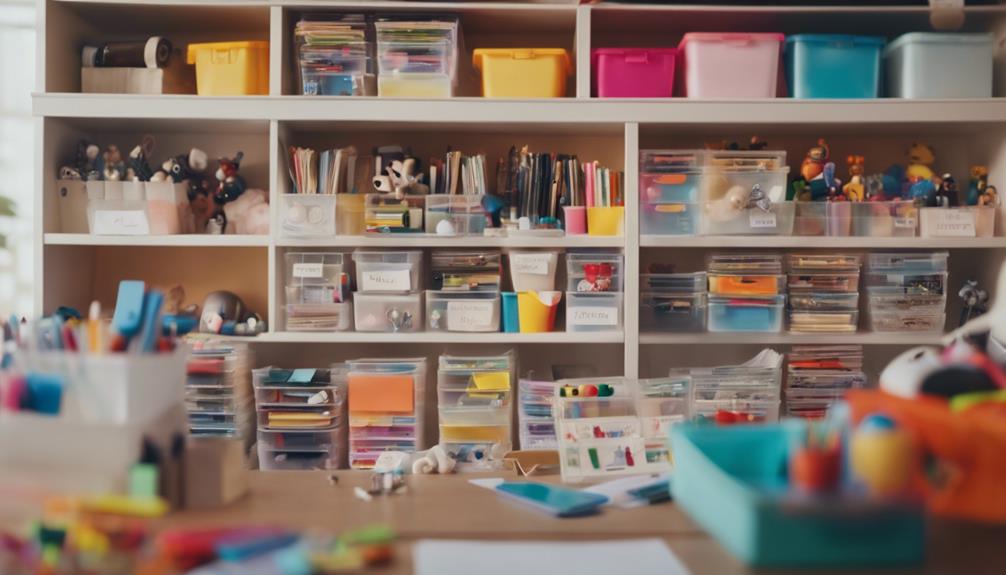
When setting up a kid-friendly workspace, using organizational tools like labeled storage bins, wall organizers, and desk drawer dividers makes a huge difference.
These tools help keep everything in its place and make it easier for kids to find what they need quickly.
Label Storage Bins
Labeling storage bins with clear, descriptive labels makes it easy to identify contents at a glance, ensuring a well-organized and efficient workspace for kids.
I find that using color-coded labels for different categories or subjects greatly enhances organization and quick retrieval.
For younger children, picture labels are invaluable since they can't read yet.
Adhesive-backed labels are my go-to because they're easy to apply and remove from various storage containers.
It's essential to regularly update and maintain these labels to keep our system consistent and efficient.
Utilize Wall Space
Maximize wall space by installing shelves, hanging folders, and wall organizers, guaranteeing that supplies are always within easy reach. This approach streamlines organization and fosters a clutter-free environment.
I like to use mounted hanging folders to categorize papers, assignments, and projects efficiently. Custom peg boards are also fantastic for hanging markers, scissors, and rulers, making them readily accessible.
Personalizing the workspace with washi tape to create customized labels not only adds a decorative touch but also enhances organization. Clear labeling on shelves and bins ensures items are easily identifiable, promoting independence and neatness.
Desk Drawer Dividers
Desk drawer dividers are a game-changer for keeping supplies organized and easily accessible in a kid-friendly workspace. By using these essential organizational tools, you can neatly separate items like pens, pencils, and markers. This not only maximizes space by creating designated compartments but also makes it easy for kids to find what they need without rummaging through a cluttered drawer.
Investing in quality desk drawer dividers promotes a sense of order, which can enhance productivity and focus in the workspace. These dividers come in various sizes and materials, fitting different drawers and organizational needs.
With a streamlined and visually appealing setup, you're fostering an efficient and enjoyable environment for your child to work and create.
Create a Cozy Corner
Creating a cozy corner can transform a simple space into an inviting haven where kids feel comfortable and ready to learn. A cozy corner in the kids' workspace is essential for fostering focus and creativity.
Start by adding soft pillows, blankets, and cushions to make the study space comfortable. Personalize the area with your child's favorite colors, artwork, or decorations to give it a unique touch. Good lighting is important to prevent eye strain and boost productivity.
A small bookshelf or storage bins can keep essential supplies and books within easy reach. This thoughtful setup guarantees a welcoming environment that enhances your child's learning experience and supports their developmental needs.
Incorporate Educational Resources
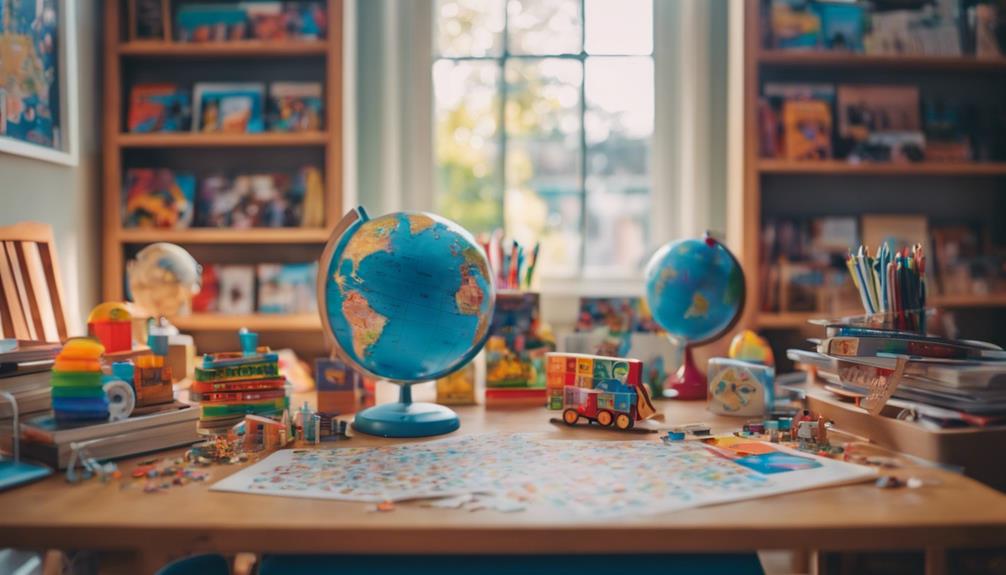
To enhance your child's learning experience, start by incorporating a variety of educational resources into their workspace. A kid-friendly home office thrives on age-appropriate materials that spark curiosity and creativity.
Consider including:
- Books: Shelves stocked with books invite your child to explore new worlds and ideas.
- Educational games and puzzles: These make learning fun and engaging, turning the workspace into a playground of knowledge.
- Online learning platforms: Access to these resources supplements traditional education, offering interactive and innovative ways to learn.
Alongside school supplies, providing art and craft materials can foster creative expression. Musical instruments or educational toys also play a significant role in developing a love for music and exploration.
Your child's workspace isn't just for study; it's a hub for discovery.
Prioritize Safety
Securing your child's workspace is crucial for their well-being and your peace of mind. First, fasten heavy furniture like bookshelves and the table to prevent tipping.
Installing safety gates can add another layer of protection. Keep kids safe by storing sharp objects and chemicals out of reach.
Regularly check and maintain equipment, addressing any safety hazards promptly. Childproofing accessories, such as outlet covers and cord organizers, are essential to prevent accidents.
By taking these steps, you create a safer workspace where your child can focus and thrive. Remember, a safe environment is the foundation of a productive and innovative learning space.
Prioritizing safety ensures that kids can explore and grow without unnecessary risks.
Personalize the Space
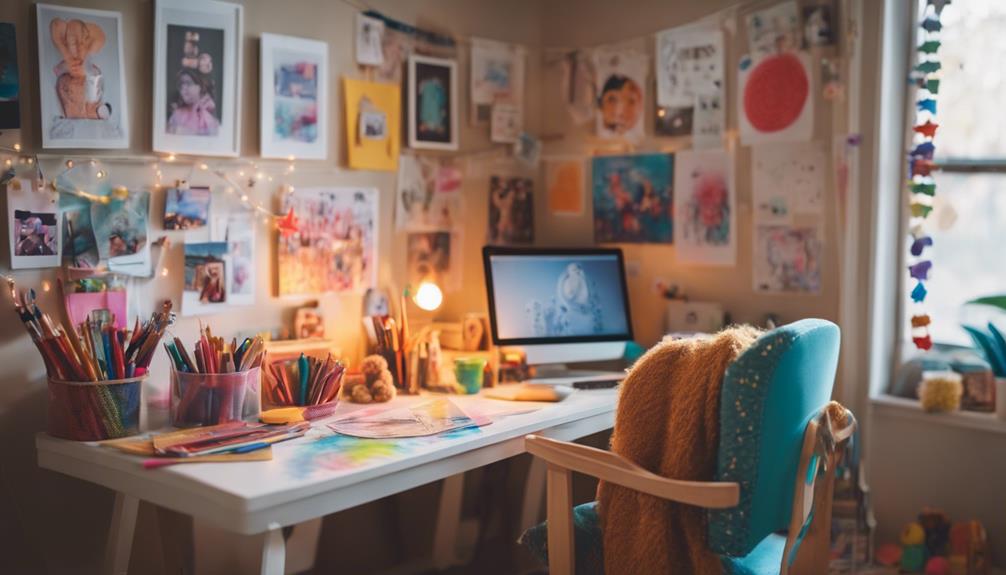
Frequently, adding personal touches to your child's workspace can greatly enhance their comfort and sense of ownership. Creating a personalized environment not only makes the area inviting but also fosters creativity and motivation for learning.
To achieve this, consider adding:
- Family photos and artwork: These familiar items provide a sense of familiarity and comfort.
- Cushions, pillows, or blankets: Enhance comfort and make the workspace more inviting.
- Plants or decorative elements: Create a visually appealing and calming atmosphere.
Balancing comfort with minimizing distractions is crucial to guarantee an effective learning environment. Allow your child to have a say in decorating their space, as this can boost their sense of ownership and make them more enthusiastic to spend time there.
Establish Ground Rules
While personalizing your child's workspace can make it inviting, setting ground rules guarantees it's also a place for productive learning.
First, establish specific study hours to create a consistent routine. This helps children know when to focus and when to relax.
Define clear breaks and snack times to maintain their concentration and provide necessary downtime. Encourage regular water intake to keep them hydrated and alert.
It's crucial to set consequences for distractions, helping them understand the importance of staying focused.
To conclude, implement a reward system for achievements. This not only motivates but also reinforces positive study habits.
Frequently Asked Questions
How Can I Make My Office Kid Friendly?
To make my office kid-friendly, I incorporate interactive toys and child-proofing measures. I use accessible storage solutions like low bookcases with categorized baskets, ensuring a safe, organized, and creative space that encourages independence and innovation.
How Do You Make a Space Child Friendly?
To make a space child-friendly, I use colorful decor and child-sized furniture to create a welcoming environment. I add interactive elements like puzzles and games to promote engagement and development, ensuring the space is both fun and functional.
How Do I Create a Good Workspace at Home?
Creating a stellar workspace at home involves choosing ergonomic furniture for comfort, considering lighting to reduce eye strain, and managing distractions. I recommend blending innovation with functionality to craft a productive and inspiring environment.
What Is a Safe Space for Kids?
A safe space for kids includes childproof locks, soft corners on furniture, and secure furniture to prevent accidents. I make sure sharp objects are out of reach and regularly inspect the area for ongoing safety.
How to Create a Safe Space for Toddlers?
Think of a fortress: I secure furniture and use childproof edges to shield toddlers. I incorporate toxic-free materials to keep them safe. My goal is to create a nurturing, innovative space where they can safely explore and grow.
Conclusion
In setting up a kid-friendly workspace, remember that 75% of parents reported improved focus when their children had dedicated study areas.
By choosing the right location, investing in child-sized furniture, ensuring proper lighting, and minimizing distractions, we're setting them up for success.
Let's also prioritize safety, use organizational tools, and personalize the space.
With these steps, our kids can thrive in a supportive, engaging environment.
Let's make learning both fun and effective!

